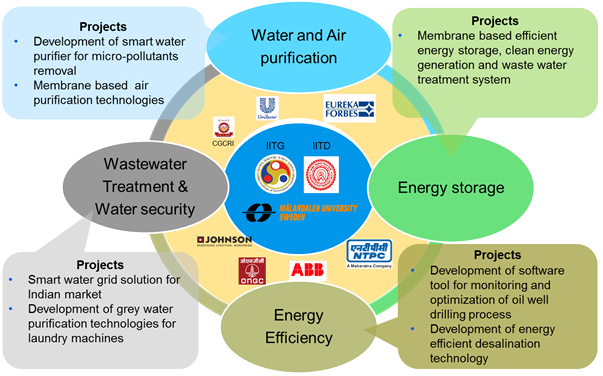
Dr. S Senthilmurugan
Professor
Key Research Areas :Modeling and Optimization of Novel Processes, Process Design and Operation of Membrane Separation Processes, Waste and waste water treatment (WWWT) for Process Industries, Novel Desalination Technologies, Smart Water Grid, Waste to Energy
- Phone No: + 91 361 258 3527
- Email: senthilmurugan@iitg.ac.in
- Room No: 0309
Email id : senthilmurugan@iitg.ac.in
Phone : 0361 258 3527 (office)
0361 258 5542 (lab)
Department of Chemical Engineering
Office Room No: 309
Water and Energy Nexus Lab Room No 306
IIT Guwahati
Assam 781039
Research
Research Publications
Considering complex and dynamic interactions among water, air recycle and energy generation, the impact on one system could directly affect other systems. Therefore developing technology for an individual system without considering the impact one on the other may not lead to a sustainable solution. Integrated sustainable water recycle and renewable energy system is very important aspect to secure water and energy sources to future generation. The development of such a system involves the solution for sustainable use of freshwater sources, cost effective wastewater recycling, and energy efficient desalination.
Both fresh water usage and wastewater generation is expected to increase, until technology for cost effective wastewater reuse and leakage detection in water distribution network is in place. The conventional wastewater treatment is not sufficient to remove the micro pollutants from wastewater and fresh water sources. Due to this, the concentration of micro pollutants are increasing with time. This problem may be resolved in two approaches: (i) isolation of micro pollutants at the point of consumption, (ii) isolation of micro pollutants at wastewater treatment plant. The second approach needs centralised water and wastewater treatment plant and proper smart water distribution network. Such a system exist in developed countries. However, in developing countries like India, first approach may be the suitable solution for implementing at low cost and second approach for long-term water sustainability solutions.
Sixty percentage of India’s total power production capacity is supplied by thermal power. The energy production using thermal cycle is water-intensive. In fact, 50 percent of industrial water used in India is for energy production. Renewable energy is the only alternate solution to minimize over all water consumption and it is proven to be economically viable solution for country like India. However, non-availability of energy storage for grid capacity is acting as a bottleneck to develop standalone grid powered by renewable energy. Therefore, development of sustainable energy storage solution that can supply 24x7 renewable power to grid is very important aspect.
Apart from innovating new systems for sustainability, research should also focus on improving efficiency of the existing energy generation system, water, and wastewater treatment system to minimize environmental damages.
For example, improving drilling efficiency for oil and gas sector may provide huge benefit in terms of more oil production and less energy consumption. India’s major energy supply is supported by oil and coal sources. ONGC is one of the major oil supplier to India. On an average, ONGC is drilling around 400 wells per year, offshore & onshore, including 110 exploratory wells to crude oil and gas production. Huge expenditures/energy are being incurred in drilling/completion of these wells. Most of the time, energy for a drilling well is consumed for Non-Productive Time (NPT) resulting from minor to major well complications and miscellaneous shutdowns. ONGC has proposed to develop a well monitoring software tool for drilling supervisors and it is expected to provide decision support to driller such that overall energy consumption for drilling can be minimized.
Another example, improving efficiency of existing indoor air purification system. While producing water and energy using conventional fossils fuels, air is polluted due to disposal of untreated flue gas in open environment and such a scenario is forcing us to use indoor air purifier to improve air quality. The HEPA based air filter is most widely used in an indoor air purifier. The HEPA based air purifier is not sufficient to remove the pollutants below recommended level by WHO, when inlet pollutant level is high. Other major disadvantages is inability to regenerate the HEPA filter. Therefore, development of membrane-based filter for air purification may enable regeneration and isolation of pollutants.
As shown in figure 1, listed research proposal may able to provide solution for above identified technology gap with respect to research areas.

Figure 1: Ongoing Research Activites Overview

